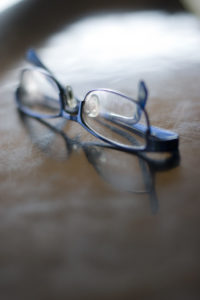My Metaphor

“Glasses” by shyb is licensed under CC BY-NC 2.0
To me, curriculum is a pair of eyeglasses. Growing up, I always wanted a pair for myself. I was jealous of the different look they give as well as how it changes the way the people see the world around them.
For this metaphor, the frames provide a solid structure similar to the predetermined content of prescribed curriculum. The style of frames can depend on different regions or countries around the world. Then from that large selection, an individual gets to choose which frame works best for them.
The glass are the lenses in which the viewer looks at the world. The wearer can look at things as a whole, see things out of focus on the periphery, or focus on something quite specific depending on the direction they look and what they are interested in. Everyone has a pair with their own specific perspective in which they are seeing the curriculum through. And as learners – both the students and educators – age and move through the education system, the prescription changes and you are able to see a little bit clearer and with more understanding of your individuality and the direction in which you want your learning to go.
My Context
I graduated with a Bachelor of Education Degree from the University of Victoria in 2014. Unfortunately, that year the teachers were on strike, so I was unable to obtain a teaching position until January of 2015. Since then I have taught primary grades and spent the last four years teaching a combination of grade two and three students at a school in West Vancouver in British Columbia (B.C.).
Therefore, I have been referencing the ‘new’ B.C. curriculum throughout my whole career. The only exposure I had to curriculum before what is currently available, was selecting specific prescribed learning outcomes (PLO’s) while writing lesson plans throughout my practicums in my undergrad program. They were overwhelming in number as a new teacher, but they provided a specific scope and sequence in the learning for each grade which, naturally, I lacked as a brand-new teacher. As a teacher who has primarily engaged in only the current curriculum in B.C., it was daunting to lose the specific learning outcomes per subject. However, as I have progressed in my teaching experience, I have enjoyed the flexibility it provides me in the classroom.
This last year has given me even more perspective on curriculum and instruction. I was fortunate to be given the amazing opportunity to take on the role of Vice Principal at my current school. Now, not only am I responsible for the learners in my own classroom, but the school as a whole. This unique position allows for me see things in a bigger picture way and think critically about how I can engage in conversations on curriculum and instruction for our school as a learning community.
My Response to Week One Articles
As made clear by my metaphor above, I believe that curriculum is the content, not the container (Egan, 2003). In the K-12 teaching world in B.C., the curricular outcomes are already predetermined and what our governing body “values and has given priority” (Blades, 1997). My job as the teacher is to then work with the students to determine how we want to move through content in a way that is engaging and follows their interests and curiosities. The curriculum documents that I reference tell me the ‘what’, but I (and the learning communities I build relationships with year to year – colleagues and students) work together to determine the ‘how’.
In reference to Blade’s (1997) article, I believe in the importance of including students in the process of curriculum and instruction in order to build ownership of the learning and allow for deeper understanding of content. As a new administrator I have needed to remind myself about the importance of including student voices in the decisions we make. In meetings there can often be so many decisions made at a high level, and our school leadership team often has to take a step back and think about what is best for our small community of learners and ask for their thoughts and feedback. We saw this very clearly during the COVID-19 school closure and transition to online and blended learning.
Resources
Blades, D. (1997) Procedures of Power in a Curriculum Discourse: Conversations from Home. JCT, 11(4), 125-155.
Egan, K. (2003) What is Curriculum? JCACS, 1(1), 9-16.
Recent Comments